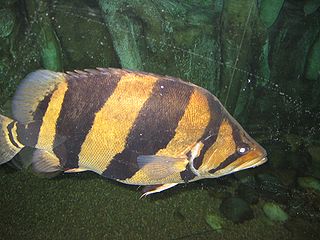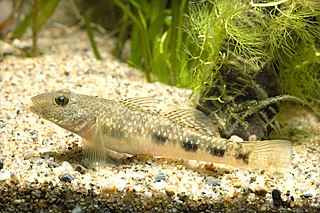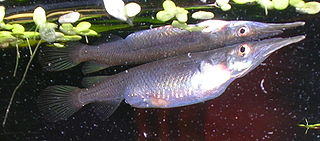
Carp are various species of oily freshwater fish from the family Cyprinidae, a very large group of fish native to Europe and Asia. While carp is consumed in many parts of the world, they are generally considered an invasive species in parts of Africa, Australia and most of the United States.

Tilapia is the common name for nearly a hundred species of cichlid fish from the coelotilapine, coptodonine, heterotilapine, oreochromine, pelmatolapiine, and tilapiine tribes, with the economically most important species placed in the Coptodonini and Oreochromini. Tilapia are mainly freshwater fish inhabiting shallow streams, ponds, rivers, and lakes, and less commonly found living in brackish water. Historically, they have been of major importance in artisanal fishing in Africa, and they are of increasing importance in aquaculture and aquaponics. Tilapia can become a problematic invasive species in new warm-water habitats such as Australia, whether deliberately or accidentally introduced, but generally not in temperate climates due to their inability to survive in cold water.

The European eel is a species of eel, a snake-like, catadromous fish. They are normally around 60–80 cm (2.0–2.6 ft) and rarely reach more than 1 m, but can reach a length of up to 1.5 m in exceptional cases.

The Indo-Pacific humpback dolphin is a species of humpback dolphin inhabiting coastal waters of the eastern Indian and western Pacific Oceans. This species is often referred to as the Chinese white dolphin in mainland China, Macao, Hong Kong, Taiwan and Singapore as a common name. Some biologists regard the Indo-Pacific dolphin as a subspecies of the Indian Ocean humpback dolphin which ranges from East Africa to India. However, DNA testing studies have shown that the two are distinct species. A new species, the Australian humpback dolphin, was split off from S. chinensis and recognized as a distinct species in 2014. Nevertheless, there are still several unresolved issues in differentiation of the Indian Ocean-type and Indo-Pacific-type humpback dolphins.

Clonorchis sinensis, the Chinese liver fluke, is a liver fluke belonging to the class Trematoda, phylum Platyhelminthes. It infects fish-eating mammals, including humans. In humans, it infects the common bile duct and gall bladder, feeding on bile. It was discovered by British physician James McConnell at the Medical College Hospital in Calcutta (Kolkata) in 1874. The first description was given by Thomas Spencer Cobbold, who named it Distoma sinense. The fluke passes its lifecycle in three different hosts, namely freshwater snail as first intermediate hosts, freshwater fish as second intermediate host, and mammals as definitive hosts.

The common dace is a species of freshwater and brackish water ray-finned fish from the family Cyprinidae which is native to Europe but which has been introduced to other parts of the world. It is a quarry species for coarse anglers.

The daggertooth pike conger also known as the darkfin pike eel in Australia, to distinguish it from the related pike-eel, is a species of eel in the pike conger family, Muraenesocidae. They primarily live on soft bottoms in marine and brackish waters down to a depth of 800 m (2,600 ft), but may enter freshwater. They commonly grow to about 1.5 m (4.9 ft) in length, but may grow as long as 2.2 m (7.2 ft). Daggertooth pike congers occur in the Red Sea, on the coast of the northern Indian Ocean, and in the West Pacific from Indochina to Japan. A single specimen was also reported in the Mediterranean Sea off Israel in 1982.

The Chinese softshell turtle is a species of softshell turtle that is native to China and Taiwan, with records of escapees—some of which have established introduced populations—in a wide range of other Asian countries, as well as Spain, Brazil and Hawaii.

Fauna of Azerbaijan or animal kingdom of Azerbaijan refers to the diversity of various types of animals, which inhabit and populate a defined ground or water area in Azerbaijan.
The Chinese bahaba, also known as the giant yellow croaker, is a critically endangered species of marine and brackish water fish in the family Sciaenidae. It is a large fish, reaching lengths up to 2 m and weights of 100 kg (220 lb). It is found on the coast of China, from the Yangtze River estuary southwards to the Pearl River estuary, including the waters of Hong Kong and Macau. Its natural habitats are shallow seas, subtidal aquatic beds, rocky shores, and estuarine waters.

The Hong Kong grouper is a species of marine ray-finned fish, a grouper from the subfamily Epinephelinae which is part of the family Serranidae, which also includes the anthias and sea basses. It is found in eastern and southeastern Asian waters of the Western Pacific Ocean. Its natural habitats are shallow seas and coral reefs.

The grass puffer, or Kusa-fugu, is a species of fish in the pufferfish family (Tetraodontidae). This common to abundant species is found in the northwest Pacific Ocean in China, Japan, Korea, the Philippines and Vietnam. It is primarily found in coastal waters, ranging to depths of 20 m (66 ft), but is often seen in brackish water and has also been recorded briefly entering freshwater. The grass puffer reaches up to 15 cm (6 in) in length.

The Siamese tigerfish, also known as the Siamese tiger perch, is a critically endangered Asian fish native to the Chao Phraya, Mae Klong and Mekong basins. It has vertical yellow and black stripes running the length of its body. The dorsal fin has a spiny appearance. Siamese tigerfish grow to 40 cm (16 in) in standard length.

Rhinogobius giurinus is a species of goby native to eastern Asia where it inhabits marine, brackish and fresh waters of rivers and estuaries. This species can reach a length of 8 centimetres (3.1 in) TL. It is of importance to local peoples as a food fish.
Dendronucleata is a genus of small parasitic spiny-headed worms. It is the only genus in the family Dendronucleatidae. This genus contains three species that are distributed globally, being collected in North America and Asia. The distinguishing features of this genus among Archiacanthocephalans is the presence of randomly distributed dendritically branched giant hypodermic nuclei. Dendronucleata parasitize freshwater fish and a salamander by attaching themselves in the intestines using their hook covered proboscis and adhesives secreted from cement glands.
The Ussuri sharpbelly is a temperate freshwater fish belonging to the subfamily Cultrinae of the family Cyprinidae. It originates in the Amur River basin in Asia. It was originally described as Culter lucidus by B. I. Dybowski in 1872, and has also been referred to as Hemiculter leucisculus lucidus in scientific literature.
Oryzias curvinotus or the Hainan medaka is a species of ricefish which is found in Quang Ninh Province in northern Vietnam and Hainan, Guangdong and Hong Kong in southern China. It is found in both fresh and brackish water. This species was described as Aplocheilus curvinotus in 1927 by J.T. Nichols and C.H. Pope with the type locality given as Nodoa, Hainan Island, China.

Zenarchopteridae, the viviparous halfbeaks, is a family in the order Beloniformes. The Zenarchopteridae exhibit strong sexual dimorphism, practicing internal fertilisation, and in some cases ovoviviparous or viviparous. The members in the family are mainly found in fresh and brackish water of tropical Asia and New Guinea, but the genus Zenarchopterus also includes marine species from the Indo-Pacific. Several, such as the wrestling halfbeak, have become commonly traded aquarium fish.

Paradiplozoon is a genus of polyopisthocotylean monogeneans, included in the family Diplozoidae.

Paradiplozoon hemiculteri is a species of monogenean of the family Diplozoidae. As in all species of this family, the bodies of the two hermaphroditic members of a couple are permanently fused for life.

















